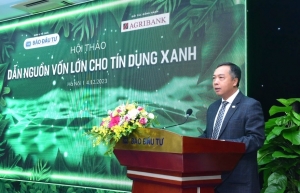Green credit now a business necessity
Bank representatives at the VIR seminar on December 4, on lighting the path for green financing and organised in conjunction with Agribank, said that many lenders are strongly participating in these efforts and bringing positive initial results.
 |
| The seminar heard that a roadmap should be crafted for implementing policies in green industries |
According to Pham Thi Thanh Tung, deputy general director of the Department of Credit for Economic Sectors under the State Bank of Vietnam (SBV), the system’s outstanding green credit balance has seen an average growth rate of more than 23 per cent annually since 2017. By September 30, outstanding green credit loans accounted for about 4.4 per cent of the economy’s total outstanding loans.
“Within the 12 green sectors prioritised by the SBV, notable emphasis has been placed on renewable energy and clean energy, constituting nearly 45 per cent, and green agriculture, which represents over 30 per cent,” Tung said, highlighting that credit institutions have fortified their environmental and social risk assessments during credit disbursement.
From a commercial banking perspective, Phung Thi Binh, deputy general director of Agribank, underscored the lender’s establishment of various large-scale agricultural models across different regions, including flower cultivation in the Central Highlands province of Lam Dong, basa fish farming in the southern province of An Giang, and corn production in the northern province of Son La. Aside from their environmental effects, these initiatives have fostered widespread collaboration between businesses and local communities.
“To date, Agribank’s clean agricultural and high-tech agricultural loan portfolio has represented half of the total capital in this sector. The outstanding loans are serving over 300 clients, predominantly farm owners and cooperative groups, with more than 98 per cent of them being individuals,” she said.
Lam Thuy Nga, country director of Large Corporate Customers at HSBC Vietnam, emphasised HSBC’s role as a conduit for substantial green capital inflow into the Vietnamese market, amounting to up to $2 billion.
“There’s substantial demand for green capital, characterising it as not only a prevailing trend but also a critical necessity for businesses, particularly those in export sectors, to adapt to international market dynamics,” Nga explained.
However, she underlined that for Vietnamese businesses to access these substantial green capital flows, numerous improvements are required, with an emphasis on aligning with international credit market standards which usually surpass those of domestic banks. Additionally, she urged businesses to avoid perceiving green credit as a source of cheap capital.
“Businesses need to see this as an investment for the future, aiming for sustainable development and shared benefits. While banks can facilitate easier access to capital and support in terms of loan tenures, conditions, and interest rates, it should still be assessed as an investment and not a cheap source of capital,” Nga noted.
On the business side, they are also waiting for green criteria to determine credit activities. HSBC currently has established internal criteria compatible with the international market, with standards that are quite stringent. “Many customers have not met them, making the customer support process time-consuming and costly due to the need to involve additional third-party consultants,” Nga added.
According to Nguyen Ba Hung, principal country economist of the Asian Development Bank in Vietnam, the country’s need for green credit and capital is apparent.
“Recent estimates from the International Finance Corporation suggest that investment in activities related to climate change in Vietnam could hit $757 billion by 2030. Of which, green credit capital from international organisations plays a role in creating momentum for market development,” Hung said.
However, to draw green credit capital, Hung suggests that the government and relevant agencies need to enhance the legal framework for green finance, aligning it with current Vietnamese practices and future international standards to ensure optimal simplicity and transparency.
“Concurrently, efforts should be directed towards enhancing the legal framework for green economic sectors as a whole and fostering the development of traditional financial markets to establish a solid foundation for green finance,” he noted.
Sharing the same vein, Tung of the SBV emphasised the need to develop a roadmap for implementing policy mechanisms that support green industries. This includes addressing aspects such as taxes, fees, capital allocation, technology integration, market development, strategic planning, and overarching development strategies for each industry and field.
“This synchronised approach aims to enhance the attractiveness and effectiveness of green credit capital,” she said.
| Vo Quoc Khanh - Partner, EY Consulting Vietnam
Within the scope of Vietnam’s financial system, the demand for green credit is immensely large. Currently, the ratio of green credit to the total outstanding debts in our economy is less than 5 per cent. What is interesting is that the growth rate of green credit in recent years has been exceeding the average growth rate of the credit sector, indicating that the proportion of green credit to total debts is poised to rise significantly, In the EU banks, the green credit ratio is nearly 8 per cent. This clearly shows that there’s a considerable room for expansion of green credit in Vietnam in the coming times, especially when you consider the scale of the opportunity. Currently, green credit is mainly in renewable energy and agriculture. But, numerous other sectors in our economy, like transport, construction materials, real estate, and even waste management have a great need for green transition. The gap between the need for and provision of green credit is significant. Addressing this is not just a task for banks; it requires joint efforts from various organisations. It also necessitates active involvement from businesses, as well as leadership and regulatory frameworks from administrative bodies. Vaibhav Saxena - Lawyer, Vilaf
Vietnam is in need of green credit, and recently there have been some studies conducted by international organisations to support Vietnam on the green journey. In order to realise this, we need to have a good generation-transmission capacity with a balance between the demand and supply needs for electricity. It shall require enormous capital from foreign and local sources, although local banks may have a money crunch for large-scale projects, which provides an opportunity for foreign lenders to utilise their allocated green capital for the planned purpose and, in parallel, provide cheaper debt by bringing in higher standards of project finance practices as per their experiences abroad. Local banks still play a vital role in syndication and can support by taking some of the local risks which international banks are not comfortable with. Both local banks and foreign banks have their own limitations. The issue is how to arrive at a workable solution. Green financing is comparatively a new entrant for Vietnam as compared to the rest of the world. However, the country is working on the legal framework for this sector and hopefully we may see a clear policy structure to enable the flow of green capital for sustainable development while supporting the green transition in Vietnam. Nguyen Van Quan - Chairman and CEO Thagaco International Investment JSC
Vietnam aspires to be the manufacturing centre of the region, focusing on major export markets like the US, EU, and Japan. In these markets, consumer concern for environmental issues is paramount. This is also reflected in free trade agreements that incorporate environmental considerations. In recent textile industry forums, there has been a marked uptick in discussions about environmental sustainability. We are witnessing a global trend where brands are vigorously pursuing a green status and demanding the same environmental commitment from their suppliers. While the impact of this greening process has not been substantial in 2023, it is rapidly becoming a non-negotiable condition for brands when selecting manufacturing partners in production countries. In recent years, we have developed smart factories that have obtained LEED certification from the US Green Building Council. But greening is not just about certification – it is about retaining customers and enhancing competitive capabilities. Building green factories is a matter of survival for all kinds of businesses. Without achieving green certification in the next 2-3 years, we risk losing major clients and market access. Green factory development is not optional – it is mandatory. |
 | Positive signs in Vietnam's green credit sector 'Green credit' refers to the kinds of loans provided by banks for projects that are considered environmentally friendly or protective of the ecosystem. Green credit is now a trend in the global banking and finance industry, and more Vietnamese banks are following suit. |
 | Vietnam's green credit surge: Navigating towards sustainable finance At a VIR seminar on December 4, in collaboration with the Vietnam Bank for Agriculture and Rural Development (Agribank), key stakeholders congregated to discuss Lighting the Path for Green Financing. The forum signified a critical juncture in Vietnam's path towards sustainable development and emphasised green economic growth. |
 | Agribank boosts ability to provide greener credit Lenders are more likely today to take a greener focus in their activities. Phung Thi Binh, deputy general director of Agribank, talked to VIR’s Nhue Man about the bank’s determination to promote green credit growth. |
What the stars mean:
★ Poor ★ ★ Promising ★★★ Good ★★★★ Very good ★★★★★ Exceptional
Related Contents
Latest News
More News
- Tax sector wraps up 2025 and sets priorities for next year (December 25, 2025 | 14:00)
- A tipping point for digital and hybrid wealth management in Vietnam (December 23, 2025 | 13:33)
- $250 million deal targets women-owned SMEs, sustainable agriculture (December 22, 2025 | 17:40)
- Stock market posts resilient 2025 performance (December 19, 2025 | 18:17)
- Citi Vietnam receives 2025 AmCham CSR recognition (December 19, 2025 | 16:35)
- As global green supply chain reshapes, will Vietnam be left behind? (December 19, 2025 | 08:00)
- Banks gear up for massive capital increases (December 18, 2025 | 17:04)
- Securing capital and efficiency for Vietnam’s 2026-2030 growth ambitions (December 17, 2025 | 10:00)
- Energy sector in need of blended finance mechanisms (December 17, 2025 | 09:00)
- Vietnam still has room to mobilise capital for sustainable growth (December 17, 2025 | 08:57)




 Tag:
Tag:





















 Mobile Version
Mobile Version